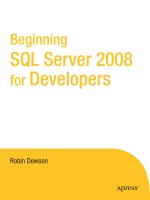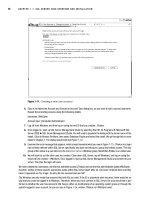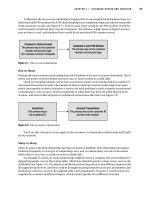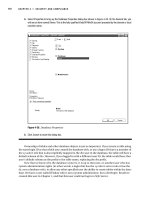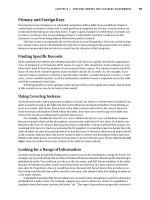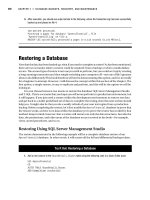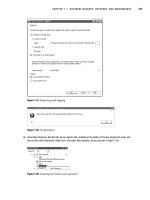Kubernetes for developers use kubernetes to develop, test, and deploy your applications with the help of containers
Bạn đang xem bản rút gọn của tài liệu. Xem và tải ngay bản đầy đủ của tài liệu tại đây (35.5 MB, 515 trang )
Kubernetes for Developers
Use Kubernetes to develop, test, and deploy your applications with
the help of containers
Joseph Heck
BIRMINGHAM - MUMBAI
Kubernetes for Developers
Copyright © 2018 Packt Publishing
All rights reserved. No part of this book may be reproduced, stored in a retrieval system, or
transmitted in any form or by any means, without the prior written permission of the
publisher, except in the case of brief quotations embedded in critical articles or reviews.
Every effort has been made in the preparation of this book to ensure the accuracy of the
information presented. However, the information contained in this book is sold without
warranty, either express or implied. Neither the author, nor Packt Publishing or its dealers
and distributors, will be held liable for any damages caused or alleged to have been caused
directly or indirectly by this book.
Packt Publishing has endeavored to provide trademark information about all of the
companies and products mentioned in this book by the appropriate use of capitals.
However, Packt Publishing cannot guarantee the accuracy of this information.
Commissioning Editor: Gebin George
Acquisition Editor: Rahul Nair
Content Development Editor: Sharon Raj
Technical Editor: Prashant Chaudhari
Copy Editor: Safis Editing
Project Coordinator: Virginia Dias
Proofreader: Safis Editing
Indexer: Priyanka Dhadke
Graphics: Tom Scaria
Production Coordinator: Deepika Naik
First edition: April 2018
Production reference: 1050418
Published by Packt Publishing Ltd.
Livery Place
35 Livery Street
Birmingham
B3 2PB, UK.
ISBN 978-1-78883-475-9
www.packtpub.com
mapt.io
Mapt is an online digital library that gives you full access to over
5,000 books and videos, as well as industry leading tools to help
you plan your personal development and advance your career. For
more information, please visit our website.
Why subscribe?
Spend less time learning and more time coding with practical
eBooks and Videos from over 4,000 industry professionals
Improve your learning with Skill Plans built especially for
you
Get a free eBook or video every month
Mapt is fully searchable
Copy and paste, print, and bookmark content
PacktPub.com
Did you know that Packt offers eBook versions of every book
published, with PDF and ePub files available? You can upgrade to
the eBook version at www.PacktPub.com and as a print book customer,
you are entitled to a discount on the eBook copy. Get in touch with
us at for more details.
At www.PacktPub.com, you can also read a collection of free technical
articles, sign up for a range of free newsletters, and receive
exclusive discounts and offers on Packt books and eBooks.
Contributors
About the author
Joseph Heck has broad development and management
experience across start-ups and large companies. He has
architected, developed, and deployed a wide variety of solutions,
ranging from mobile and desktop applications to cloud-based
distributed systems.
He builds and directs teams and mentors individuals to improve
the way they build, validate, deploy, and run software. He also
works extensively with and in open source, collaborating across
many projects, including Kubernetes.
About the reviewers
Paul Adamson has worked as an Ops engineer, a developer, a
DevOps engineer, and all variations and mixes of these. When not
reviewing this book, he keeps busy helping companies embrace the
AWS infrastructure. His language of choice is PHP for all the
good reasons and even some of the bad ones, but mainly habit.
Apart from reviewing this book, he has been working for Healthy
Performance Ltd., helping to apply cutting-edge technology to a
cutting-edge approach to wellbeing.
Jakub Pavlik is a co-founder, former CTO, and chief architect of
tcp cloud who has worked several years on the IaaS cloud platform
based on OpenStack-Salt and OpenContrail projects, which were
deployed and operated for global large service providers. Currently
as the director of product engineering, he collaborates on a new
Mirantis Cloud Platform for NFV/SDN, IoT, and big data use cases
based on Kubernetes, containerized OpenStack, and OpenContrail.
He is a member of the OpenContrail Advisory Board and is also an
enthusiast of Linux OS, ice hockey, and films. He loves his wife,
Hanulka.
Packt is searching for authors
like you
If you're interested in becoming an author for Packt, please visit aut
hors.packtpub.com and apply today. We have worked with thousands of
developers and tech professionals, just like you, to help them share
their insight with the global tech community. You can make a
general application, apply for a specific hot topic that we are
recruiting an author for, or submit your own idea.
Preface
It's getting more common to find yourself responsible for running
the code you've written as well as developing the features. While
many companies still have an operations group (generally retitled
to SRE or DevOps) that help with expert knowledge, developers
(like you) are often being asked to expand your knowledge and
responsibility scope.
There's been a shift to treating infrastructure-like code for some
time. Several years ago, I might have described the boundary as
Puppet is used by operations folks and Chef is used by developers.
All of that changed with the advent and growth first of clouds in
general, and more recently with the growth of Docker. Containers
provide a level of control and isolation, as well as development
flexibility, that is very appealing. When using containers, you
quickly move to where you want to use more than one container a
time, for isolation of responsibility as well as horizontal scaling.
Kubernetes is a project open sourced from Google, now hosted by
the cloud-native computing foundation. It exposes many of the
lessons from Google's experience of running software in containers
and makes it available to you. It encompasses not only running
containers, but grouping them together into services, scaling them
horizontally, as well as providing means to control how these
containers interact together and how they get exposed to the
outside world.
Kubernetes provides a declarative structure backed with an API and
command-line tools. Kubernetes can be used on your laptop, or
leveraged from one of the many cloud providers. The benefit of
using Kubernetes is being able to use the same set of tools with the
same expectations, regardless of running it locally, in a small lab at
your company, or in any number of larger cloud providers. It's not
exactly the write once, run anywhere promise of Java from days
gone by; more we'll give you a consistent set of tools, regardless of
running on your laptop, your company's datacenter, or a cloud
provider such as AWS, Azure, or Google.
This book is your guide to leveraging Kubernetes and its
capabilities for developing, validating, and running your code.
This book focuses on examples and samples that take you through
how to use Kubernetes and integrate it into your development
workflow. Through the examples, we focus on common tasks that
you may want to use to take advantage of running your code with
Kubernetes.
Who this book is for
If you are a full-stack or backend software developer who's
interested in, curious about, or being asked to be responsible for
testing and running the code you're developing, you can leverage
Kubernetes to make that process simpler and consistent. If you're
looking for developer-focused examples in Node.js and Python for
how to build, test, deploy, and run your code with Kubernetes, this
book is perfect for you.
What this book covers
, Setting Up Kubernetes for Development, covers the
installation of kubectl, minikube, and Docker, and running kubectl
with minikube to validate your installation. This chapter also
provides an introduction to the concepts in Kubernetes of Nodes,
Pods, Containers, ReplicaSets, and Deployments.
Chapter 1
, Packaging Your Code to Run in Kubernetes, explains how
to package your code within containers in order to use Kubernetes
with examples in Python and Node.js.
Chapter 2
, Interacting with Your Code in Kubernetes, covers how to
run containers in Kubernetes, how to access these containers, and
introduces the Kubernetes concepts of Services, Labels, and
Selectors.
Chapter 3
, Declarative Infrastructure, covers expressing your
application in a declarative structure, and how to extend that to
utilize the Kubernetes concepts of ConfigMaps, Annotations, and
Secrets.
Chapter 4
, Pod and Container Lifecycles, looks at the life cycle of
containers and Pods within Kubernetes, and how to expose hooks
from your application to influence how Kubernetes runs your code,
and how to terminate your code gracefully.
Chapter 5
, Background Processing in Kubernetes, explains the batch
processing concepts in Kubernetes of Job and CronJob, and
introduces how Kubernetes handles persistence with Persistent
Volumes, Persistent Volume Claims, and Stateful Sets.
Chapter 6
, Monitoring and Metrics, covers monitoring in Kubernetes,
and how to utilize Prometheus and Grafana to capture and display
metrics and simple dashboards about Kubernetes in general, as
well as your applications.
Chapter 7
, Logging and Tracing, explains how to collect logs with
Kubernetes using ElasticSearch, FluentD, and Kibana, and how you
can set up and use distributed tracing with Jaeger.
Chapter 8
, Integration Testing, covers testing strategies that take
Chapter 9
advantage of Kubernetes, and how to leverage Kubernetes in
integration and end-to-end tests.
, Troubleshooting Common Problems and Next Steps,
reviews a number of common pain points you may encounter when
getting started with Kubernetes and explains how to resolve them,
and provides an overview of a number of projects within the
Kubernetes ecosystem that may be of interest to developers and
the development process.
Chapter 10
To get the most out of this
book
You need to have the following software and hardware
requirements:
Kubernetes 1.8
Docker Community Edition
kubectl 1.8 (part of Kubernetes)
VirtualBox v5.2.6 or higher
minikube v0.24.1
MacBook or Linux machine with 4 GB of RAM or more
Download the example code
files
You can download the example code files for this book from your
account at www.packtpub.com. If you purchased this book elsewhere, you
can visit www.packtpub.com/support and register to have the files emailed
directly to you.
You can download the code files by following these steps:
1. Log in or register at www.packtpub.com.
2. Select the SUPPORT tab.
3. Click on Code Downloads & Errata.
4. Enter the name of the book in the Search box and follow the
onscreen instructions.
Once the file is downloaded, please make sure that you unzip or
extract the folder using the latest version of:
WinRAR/7-Zip for Windows
Zipeg/iZip/UnRarX for Mac
7-Zip/PeaZip for Linux
The code bundle for the book is also hosted on GitHub at following
URLs:
/>
/>
/>
In case there's an update to the code, it will be updated on the
existing GitHub repository.
We also have other code bundles from our rich catalog of books
and videos available at Check them
out!
Conventions used
There are a number of text conventions used throughout this book.
: Indicates code words in text, database table names, folder
names, filenames, file extensions, pathnames, dummy URLs, user
input, and Twitter handles. Here is an example: "Mount the
downloaded WebStorm-10*.dmg disk image file as another disk in your
system."
CodeInText
A block of code is set as follows:
import signal
import sys
def sigterm_handler(_signo, _stack_frame):
sys.exit(0)
signal.signal(signal.SIGTERM, sigterm_handler)
When we wish to draw your attention to a particular part of a code
block, the relevant lines or items are set in bold:
import signal
import sys
def sigterm_handler(_signo, _stack_frame):
sys.exit(0)
signal.signal(signal.SIGTERM, sigterm_handler)
Any command-line input or output is written as follows:
kubectl apply -f simplejob.yaml
Bold: Indicates a new term, an important word, or words that you
see onscreen. For example, words in menus or dialog boxes appear
in the text like this. Here is an example: "Select System info from
the Administration panel."
Warnings or important notes appear like this.
Tips and tricks appear like this.
Get in touch
Feedback from our readers is always welcome.
General feedback: Email and mention the book
title in the subject of your message. If you have questions about
any aspect of this book, please email us at
Errata: Although we have taken every care to ensure the accuracy
of our content, mistakes do happen. If you have found a mistake in
this book, we would be grateful if you would report this to us.
Please visit www.packtpub.com/submit-errata, selecting your book, clicking
on the Errata Submission Form link, and entering the details.
Piracy: If you come across any illegal copies of our works in any
form on the Internet, we would be grateful if you would provide us
with the location address or website name. Please contact us at
with a link to the material.
If you are interested in becoming an author: If there is a
topic that you have expertise in and you are interested in either
writing or contributing to a book, please visit authors.packtpub.com.
Reviews
Please leave a review. Once you have read and used this book, why
not leave a review on the site that you purchased it from? Potential
readers can then see and use your unbiased opinion to make
purchase decisions, we at Packt can understand what you think
about our products, and our authors can see your feedback on their
book. Thank you!
For more information about Packt, please visit packtpub.com.
Setting Up Kubernetes for
Development
Welcome to Kubernetes for Developers! This chapter starts off by
helping you get the tools installed that will allow you to take
advantage of Kubernetes in your development. Once installed, we
will interact with those tools a bit to verify that they are functional.
Then, we will review some of the basic concepts that you will want
to understand to effectively use Kubernetes as a developer. We will
cover the following key resources in Kubernetes:
Container
Pod
Node
Deployment
ReplicaSet
What you need for
development
In addition to your usual editing and programming tools, you will
want to install the software to leverage Kubernetes. The focus of
this book is to let you do everything on your local development
machine, while also allowing you to expand and leverage a remote
Kubernetes cluster in the future if you need more resources. One
of Kubernetes' benefits is how it treats one or one hundred
computers in the same fashion, allowing you to take advantage of
the resources you need for your software, and do it consistently,
regardless of where they're located.
The examples in this book will use command-line tools in a
Terminal on your local machine. The primary one will be kubectl,
which communicates with a Kubernetes cluster. We will use a tiny
Kubernetes cluster of a single machine running on your own
development system with Minikube. I recommend installing the
community edition of Docker, which makes it easy to build
containers for use within Kubernetes:
:
kubectl kubectl
(how to pronounce that is an amusing diversion
within the Kubernetes community) is the primary commandline tool that is used to work with a Kubernetes cluster. To
install kubectl, go to the page />tall-kubectl/
and follow the instructions relevant to your
platform.
: To install Minikube, go to the page />
minikube
rnetes/minikube/releases
and follow the instructions for your
platform.
: To install the community edition of Docker, go to the
docker
webpage and follow their
instructions for your platform.

![oracle adf enterprise application development - made simple [electronic resource] successfully plan, develop, test, and deploy applications with oracle adf](https://media.store123doc.com/images/document/14/y/kr/medium_krn1401473312.jpg)

